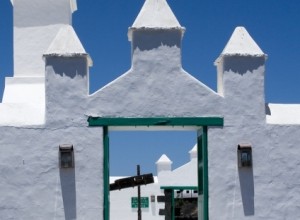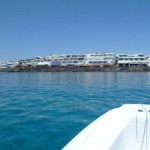Casa-museo del Campesino and Monumento a la Fecundidad in Lanzarote

In the geographical centre of Lanzarote, at an important crossroads whence any part of the island can be reached, there stands one of the works of César Manrique that carries that most symbolic references: the architectonic collection of the Casa-Museo del Campesino y Monumento a la Fecundidad (Museum-House and Monument to Fertility).
An imaginary central axis running through the island would pass through Mozaga, in the municipality of San Bartolomé, where three different agricultural areas meet: the jable, the artificial enarenados (method of dry cultivation) and the natural enarenados of La Geria.
It is made up of a series of buildings which are inspired by typically traditional Lanzaroteña architecture: not reproducing an existing concrete model but rather combining the most characteristic elements of the island’s distinct geographical areas. The museum-house contains representative elements such as chimneys, threshing floors, wells, patios, carpentry, presses, etc.
César Manrique always showed his fascination with popular architecture, which he deemed to be a symbol of the island’s identity and one of its distinctive features. In 1972, in a book titled «Lanzarote, arquitectura inédita», he compiled an extensive photographic inventory which contains the most significant aspects of Lanzarote’s traditional architecture.
The «Fecundidad» Sculpture
A monumental sculpture known as «Fecundidad» («Fertility»), dedicated to the Lanzaroteño farmer, stands alone on the horizon. It is made of old water tanks from yachts and various other objects that were painted and assembled together, forming a collection of visually striking geometric shapes.
The «Fecundidad» sculpture was completed in 1968. The piece was designed by César Manrique, while its actual creation was overseen by Jesús Soto, César’s collaborator in nearly all the spatial works in Lanzarote. As the works progressed, a number of technical problems had to be solved owing to the sculpture’s complexity, not only because of its height – 15 metres – but also those caused by its resistance to the wind. Iron and concrete were mainly used in its construction.
It rests on a mound of stones known as La Peña de Tajaste, a tiny islet that was not affected by past volcanic activity. Artistically, we can see the audacity in placing cubic structures symbolising a person on a beast of burden. The purity of the lines and the volumetric modularity make the sculpture a magnificent reflection of avant-garde art.
The Casa-Museo del Campesino (Museum House)
As regards the group of buildings that make up the Casa-Museo del Campesino, we can see the semi-circular floor that surrounds an open, central square or plaza with a number of buildings distributed around it. Inside those buildings, we can look at many objects and tools relating to the island?s culture and agriculture.
The Casa-Museo del Campesino and the Monumento a la Fecundidad constitute a lucid, avant-garde look at the island?s architecture and which currently takes on a new relevance, mainly in light of the bridge it builds between the traditional and the modern.
New interventions
Continuing a project developed by César Manrique prior to his untimely death, additional constructions were added to the Casa Museo. These were created inside a former stone quarry. The works consisted mainly in the creation of new areas with specific uses: restaurant, centre for retailing artisanal products, esplanade for folkloric exhibitions, craftsmen’s workshops, etc.
The strategic position of the Casa-Museo del Campesino and the Monumento a la Fecundidad make it the key starting point from which all the various routes run for visits to the remaining Centres of Art, Culture and Tourism (Centros de Arte, Cultura y Turismo).
Centre: 10:00 to 17:45 h. and in the summer, 09:00 to 17:45
Cafe & Shop: 10:00 to 17:45 and in the summer 09:00 to 17:45
Restaurant: 12:00 to 16:00
Summer opening hours (15 July – 15 September)
Apartments in Lanzarote: La Tegala
























